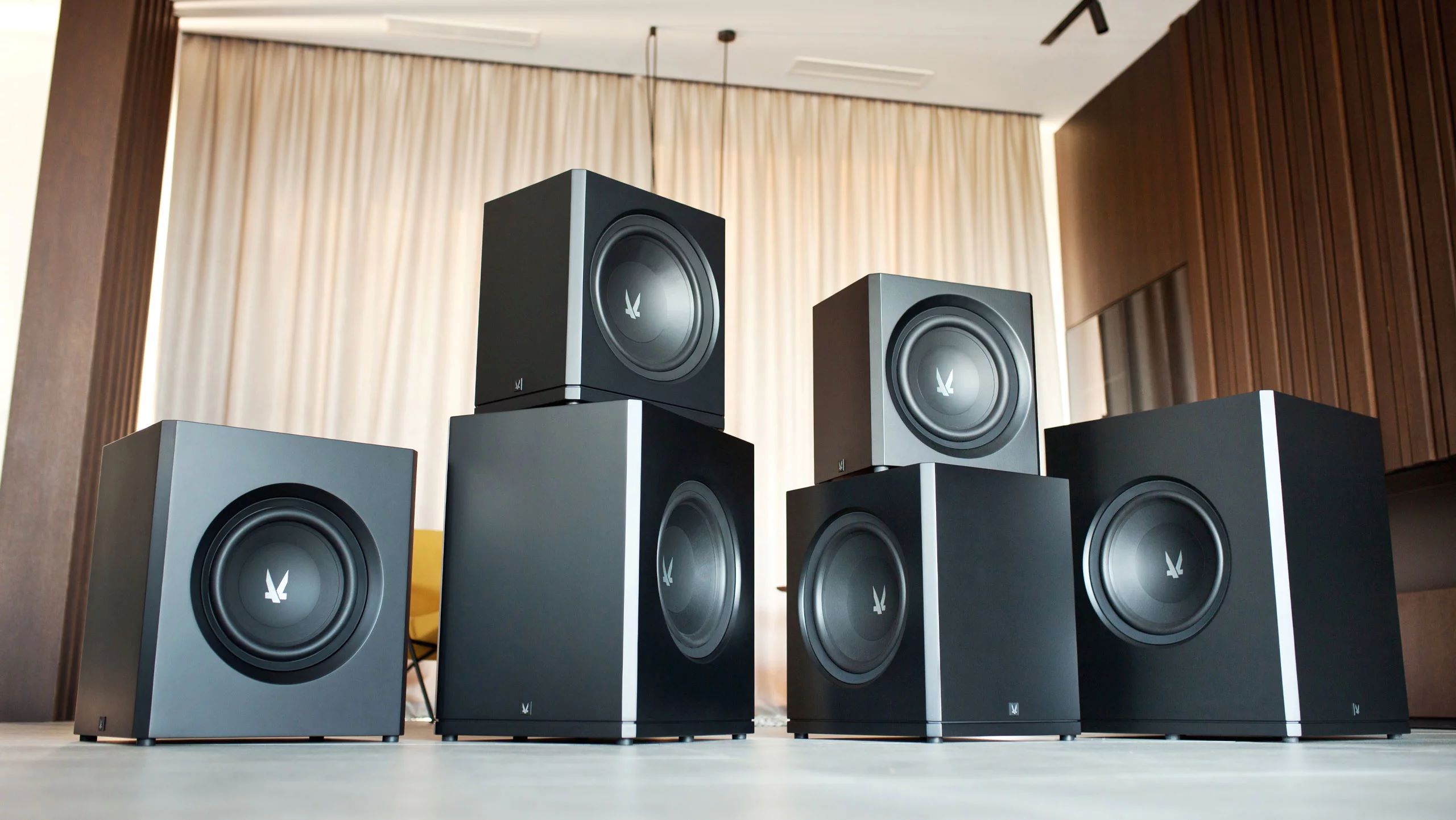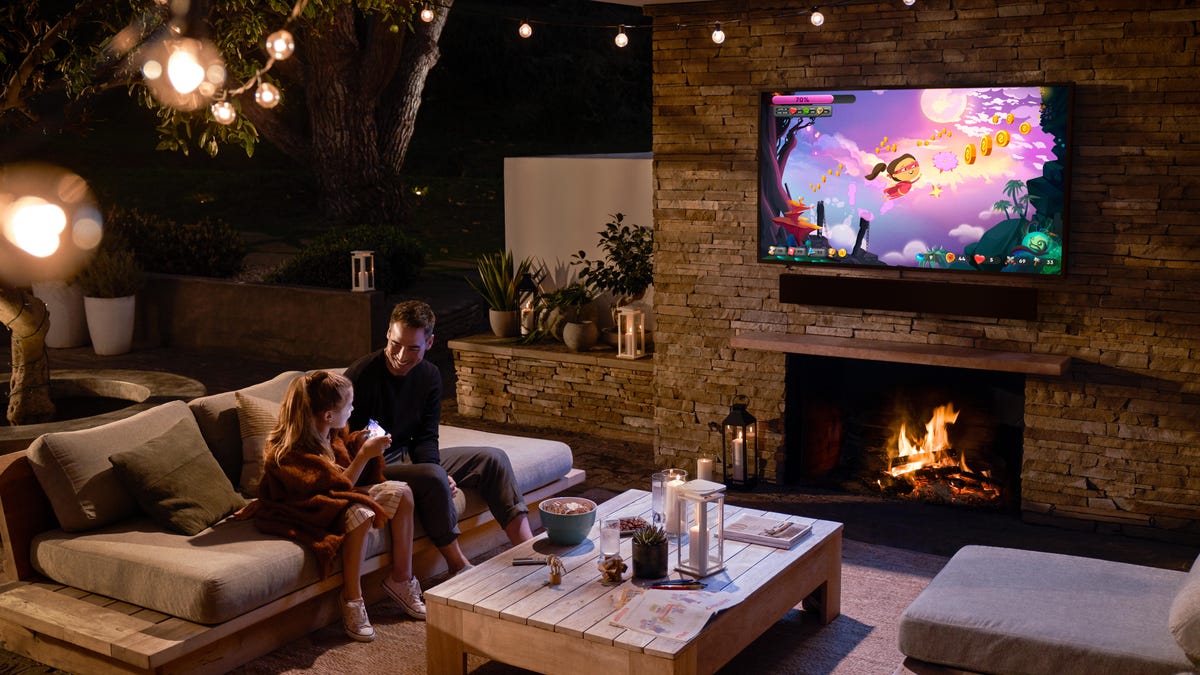Home>Devices & Equipment>Subwoofer>How Loud Should A Subwoofer Be


Subwoofer
How Loud Should A Subwoofer Be
Published: January 22, 2024
Discover the optimal sound level for your subwoofer with our expert guide. Find out how loud your subwoofer should be for the best audio experience.
(Many of the links in this article redirect to a specific reviewed product. Your purchase of these products through affiliate links helps to generate commission for AudioLover.com, at no extra cost. Learn more)
Table of Contents
- Introduction
- Understanding Subwoofer Loudness
- Finding the Optimal Subwoofer Loudness
- Factors to Consider for Subwoofer Loudness
- Setting the Subwoofer Volume
- Testing and Adjusting Subwoofer Loudness
- Balancing Subwoofer Loudness with Other Speakers
- The Importance of Room Acoustics
- Common Mistakes to Avoid with Subwoofer Loudness
- Conclusion
Introduction
When it comes to audio systems, a subwoofer plays a crucial role in delivering deep, low-frequency sounds that add depth and realism to your music, movies, and gaming experiences. The power and loudness of a subwoofer can greatly impact your overall audio enjoyment. However, finding the right balance and setting for subwoofer loudness can be a daunting task for many enthusiasts.
In this article, we will dive into the world of subwoofer loudness and discuss how to find the optimal level for your setup. We will explore the factors to consider, the importance of room acoustics, and common mistakes to avoid. Whether you’re a seasoned audiophile or a newcomer to the world of subwoofers, this article aims to provide you with valuable insights and practical tips that will help you get the most out of your subwoofer.
Understanding how loud a subwoofer should be is not just about cranking up the bass to the maximum level. It involves finding the right balance where the subwoofer seamlessly integrates with the rest of your audio system, enhancing the overall audio experience without overpowering or distorting other frequencies.
So, let’s embark on this journey to explore the intricate world of subwoofer loudness and discover how to achieve the perfect blend of power and finesse for your audio setup!
Understanding Subwoofer Loudness
Subwoofer loudness refers to the volume or level at which the subwoofer plays low-frequency sounds. It is measured in decibels (dB) and determines the intensity of the bass output in your audio system. Understanding subwoofer loudness is essential for achieving optimal audio balance and ensuring a satisfying listening experience.
Low-frequency sounds, such as deep bass, are typically felt rather than heard. They provide a foundation and impact that can greatly enhance the overall immersion and realism of your audio content. A subwoofer is specifically designed to reproduce these low-frequency sounds accurately, delivering powerful and deep bass notes that regular speakers cannot replicate.
However, it’s crucial to strike the right balance when it comes to subwoofer loudness. Too low and the impact of the bass may be underwhelming, while too high can result in overpowering bass that masks other frequency ranges and distorts the overall sound quality. Achieving the optimum loudness level of your subwoofer will result in a well-balanced audio experience that maintains clarity, depth, and realism.
One important aspect to consider is that subwoofer loudness is subjective and can vary depending on personal preference and the content being played. For example, watching an action movie may require a slightly higher subwoofer loudness to experience the intensity of explosions and rumbling effects, while listening to jazz music may call for a subtler and more refined bass presence.
Additionally, the size and power rating of your subwoofer will also influence its loudness capabilities. Larger subwoofers generally have greater power and can produce more intense bass, while smaller models are suitable for smaller spaces or when a more subtle bass presence is desired.
Understanding the concept of subwoofer loudness is the first step in achieving the perfect bass balance in your audio system. In the following sections, we will explore how to find the optimal loudness level for your subwoofer, taking into consideration various factors and practical tips to fine-tune your audio setup.
Finding the Optimal Subwoofer Loudness
Finding the optimal loudness level for your subwoofer involves a combination of personal preference and careful calibration. Here are some steps you can follow to find the right balance:
- Start with a neutral setting: Begin by setting all your audio settings, including the subwoofer volume, to a neutral or default position. This will serve as a baseline for making adjustments.
- Listen to reference tracks: Choose a selection of songs or audio tracks that you know well and that cover a wide range of genres. Listen to these reference tracks with your subwoofer at a moderate volume and pay attention to the quality and impact of the bass. Make note of any areas where the bass may be overpowering or lacking presence.
- Adjust the subwoofer volume: Gradually increase or decrease the volume of the subwoofer to fine-tune the bass levels. Listen to the reference tracks again and pay attention to how the bass integrates with the rest of the audio. Aim for a balanced and cohesive sound, where the bass enhances the overall listening experience without overpowering other frequencies.
- Consider room acoustics: The room in which your audio system is set up plays a significant role in subwoofer performance. Experiment with subwoofer placement and positioning to find the best spot that minimizes sound distortion and maximizes bass impact. You may need to adjust the volume accordingly to achieve optimal results in different room configurations.
- Take breaks and re-evaluate: After making adjustments, take breaks from listening to give your ears a rest. Return to your audio system with fresh ears and reassess the bass levels. This will help you determine if further tweaks are necessary or if you’ve achieved the desired balance.
Remember that finding the optimal subwoofer loudness is a continuous process, and it may require some trial and error to achieve the perfect balance. Don’t be afraid to experiment and trust your ears to guide you along the way.
In the next section, we will delve into the factors that should be considered when determining the loudness level of your subwoofer for an immersive audio experience.
Factors to Consider for Subwoofer Loudness
When setting the loudness level of your subwoofer, there are several factors that you should take into consideration to achieve the best possible audio experience:
- Room size and layout: The size and layout of the room can significantly impact the performance of your subwoofer. Larger rooms may require a higher subwoofer loudness to fill the space with deep bass, while smaller rooms may need a more restrained bass presence to prevent overwhelming the listening area. Experiment with subwoofer placement and adjust the loudness accordingly to achieve optimal results in your specific room.
- Speaker configuration: The number and type of speakers in your audio setup can influence the subwoofer loudness. If you have a dedicated center speaker, surround speakers, or a complete home theater system, you may need to adjust the subwoofer’s volume to ensure it blends seamlessly with the other speakers. Harmonizing the bass output with the rest of your speakers creates a cohesive soundstage and enhances audio immersion.
- Content type: Different types of audio content, such as movies, music, or video games, may require different subwoofer loudness settings. Action-packed movies or games with explosive sound effects may benefit from a higher subwoofer volume to reproduce deep rumbling sensations, while music with intricate bass lines may require a subtler and more nuanced approach. Adjust the loudness based on the content you are experiencing to achieve the desired impact and clarity.
- Listening preferences: Remember that subwoofer loudness is subjective and personal preferences may vary. Some individuals prefer a more pronounced and powerful bass presence, while others may prefer a more balanced and controlled bass output. Take your listening preferences into account when adjusting the subwoofer volume to ensure a satisfying audio experience that aligns with your preferences.
- Surround sound processing: If your audio system includes any type of surround sound processing, such as Dolby Atmos or DTS:X, you may need to adjust the subwoofer loudness to optimize the effectiveness of these technologies. Consult the user manual or documentation of your audio equipment to understand any specific recommendations or guidelines for subwoofer volume settings in relation to surround sound processing.
By considering these factors, you can fine-tune the subwoofer loudness to create a captivating audio experience that brings your music, movies, and games to life.
In the next section, we will explore the process of setting the subwoofer volume in more detail, providing you with practical tips to achieve the optimal loudness level.
Setting the Subwoofer Volume
Setting the volume of your subwoofer is a crucial step in achieving the optimal loudness level and ensuring a balanced audio experience. Here are some tips on how to set the subwoofer volume effectively:
- Use test tones: Many AV receivers or audio calibration tools provide built-in test tones specifically designed for setting the subwoofer volume. These tones emit a signal at a specific frequency, allowing you to adjust the subwoofer volume until the desired level is achieved. Test tones help ensure accurate and precise adjustments for optimal bass integration.
- Use your ears: While test tones can provide a good starting point, don’t solely rely on them. Use your ears as the final judge. Listen to various audio tracks that cover a wide range of frequencies and pay attention to how the subwoofer bass blends with the rest of the sound. Fine-tune the volume until you achieve a balanced and pleasing bass reproduction.
- Consider crossover settings: The crossover settings determine the frequency at which the subwoofer takes over from the main speakers. Adjusting the crossover settings can help improve the integration between the subwoofer and the other speakers, ensuring a seamless transition between low and high frequencies. Experiment with different crossover frequencies and adjust the subwoofer volume accordingly to find the best balance.
- Avoid excessive volume: It may be tempting to crank up the subwoofer volume to feel the bass rumble, but excessive volume can lead to distortion, overpowering other frequencies, and causing listener fatigue. Gradually increase the volume until you reach a level that enhances the overall listening experience without compromising audio quality.
- Consider room equalization: Some AV receivers or audio systems offer room equalization features that analyze room acoustics and automatically adjust the subwoofer volume and other audio parameters for optimal performance. Utilize these features to optimize the subwoofer volume based on your specific room’s characteristics.
Remember that setting the subwoofer volume is a dynamic process, and it may require periodic adjustments as you encounter different audio content or make changes to your audio system setup. Trust your ears and take the time to fine-tune the volume to achieve the perfect bass balance.
In the next section, we will discuss how to test and adjust the subwoofer loudness to ensure precise and accurate results.
Testing and Adjusting Subwoofer Loudness
Testing and adjusting the subwoofer loudness is a crucial step in ensuring that you achieve optimal audio performance and a balanced bass response. Here are some steps to help you test and fine-tune the subwoofer loudness:
- Play a variety of audio content: To accurately assess the subwoofer loudness, listen to a wide range of audio content, including music, movies, and games. Pay attention to the bass response and how it integrates with the rest of the audio. Different genres and content types may require adjustments to achieve the desired balance.
- Listen for bass overpowering: While a robust bass presence can enhance the listening experience, it should never overpower the other frequencies in the audio. If you notice that the bass is overpowering or distorting the rest of the sound, reduce the subwoofer volume slightly to achieve a more balanced blend.
- Listen for weak bass: On the other hand, if you feel that the bass is lacking impact and presence, you may need to increase the subwoofer volume. However, be cautious not to sacrifice the clarity and quality of the other frequency ranges in pursuit of more bass. Aim for a harmonious blend.
- Make incremental adjustments: When making adjustments to the subwoofer volume, do so in small increments. This will allow you to fine-tune the bass response gradually without drastic changes that may have unintended consequences. Listen to the results after each adjustment to determine if further tweaking is necessary.
- Use a sound level meter: A sound level meter can be a helpful tool to measure and ensure consistent loudness levels across different audio content. Place the sound level meter near your listening position and adjust the subwoofer volume until it aligns with the recommended dB level provided by the meter or your personal preferences.
- Consider room correction: Room correction software or devices can analyze the acoustics of your listening space and make precise adjustments to the subwoofer’s loudness to compensate for any room-related issues. Utilize these tools to further refine the bass response and achieve optimal audio performance.
Remember that testing and adjusting the subwoofer loudness is a continuous process that may require experimentation and fine-tuning over time. Trust your ears and take the time to listen carefully to achieve the best results for your audio system.
In the next section, we will discuss how to balance subwoofer loudness with the other speakers in your setup to create a cohesive and immersive audio experience.
Balancing Subwoofer Loudness with Other Speakers
Creating a balanced audio experience involves ensuring that the subwoofer’s loudness harmonizes effectively with the other speakers in your setup. Here are some tips for balancing subwoofer loudness with the rest of your speakers:
- Consider speaker size and capabilities: Different speakers have varying capabilities when it comes to reproducing bass frequencies. Take into account the size and power of your main speakers, center channel, and surround speakers. Adjust the subwoofer volume to complement the bass output of these speakers and create a cohesive soundstage.
- Set proper crossover frequency: The crossover frequency determines the point at which the subwoofer takes over from the main speakers. Adjusting the crossover frequency can help ensure a smooth transition between frequencies and prevent any gaps or overlap. Experiment with different crossover settings and adjust the subwoofer volume accordingly to achieve seamless integration.
- Pay attention to dialogue clarity: In a home theater setup, the center channel speaker is responsible for dialogue reproduction. Make sure that the subwoofer’s loudness does not overpower the center speaker, as it may result in muddled or distorted dialogue. Adjust the subwoofer volume to maintain clarity in dialogue while still enhancing the overall bass impact.
- Use sound isolation and positioning: Consider using sound isolation materials or speaker positioning techniques to prevent unwanted vibrations or resonances that may affect the balance between the subwoofer and other speakers. Proper placement of the subwoofer in relation to the main listening area can help create a more immersive and cohesive audio experience.
- Calibrate your audio system: Utilize the calibration features available in your AV receiver or audio processor to ensure accurate speaker levels and proper integration of the subwoofer. These calibration systems use test tones and advanced algorithms to optimize the loudness levels and timings of all speakers, including the subwoofer, for a well-balanced audio output.
By paying attention to the size, capabilities, and positioning of your speakers, and adjusting the subwoofer volume to complement them, you can achieve a balanced audio experience where each speaker contributes its unique strengths to create a cohesive and immersive soundstage.
In the next section, we will explore the importance of room acoustics when it comes to subwoofer loudness and how it can impact your overall listening experience.
The Importance of Room Acoustics
Room acoustics play a critical role in the performance and perception of subwoofer loudness. The way sound interacts with the physical characteristics of your room can greatly impact the bass response and overall audio experience. Understanding and optimizing room acoustics is essential for achieving the best possible subwoofer performance. Here’s why room acoustics matter:
Frequency response: Different room dimensions and materials can create peaks and nulls in the frequency response, causing certain frequencies to be amplified or attenuated. This directly affects the perceived loudness of the subwoofer. By addressing room acoustics through the use of bass traps, diffusers, and acoustic panels, you can minimize these frequency irregularities and achieve a more balanced and accurate bass response.
Room modes and standing waves: Room modes are resonant frequencies that occur within your room’s boundaries, causing certain bass frequencies to become overly emphasized or canceled out. This can result in boomy or weak bass response in certain areas of the room. Proper subwoofer placement and bass management, along with room treatments, can help mitigate the effects of room modes and standing waves, creating a more even bass distribution.
Bass decay and reflections: The size, shape, and materials of your room can impact the decay and reflection of bass frequencies. Excessive bass decay can lead to a muddy or blurred bass response, while excessive reflections can result in a lack of clarity and definition. Room treatments, such as bass traps and absorptive materials, can help control these issues, allowing for a cleaner and more precise bass reproduction.
Listening position: The placement of your listening position within the room can also affect subwoofer loudness. Standing too close to walls or corners can create bass buildup and reinforce certain frequencies, while sitting too far away from the subwoofer may result in a weaker bass perception. Finding the optimal listening position, along with proper subwoofer placement, can help achieve a balanced and immersive bass experience.
Considering the importance of room acoustics, it’s essential to assess and address any issues that may impact subwoofer loudness. Experiment with subwoofer and speaker placement, utilize room treatments, and consider professional acoustic analysis and solutions if needed. By optimizing room acoustics, you can unleash the full potential of your subwoofer and enjoy a more accurate and enjoyable audio listening experience.
In the final section, we will highlight some common mistakes to avoid when setting subwoofer loudness to help you achieve the best possible results.
Common Mistakes to Avoid with Subwoofer Loudness
When striving to achieve optimal subwoofer loudness, there are several common mistakes that should be avoided. By being aware of these pitfalls, you can ensure a more accurate and balanced audio experience. Here are some common mistakes to watch out for:
- Overpowering the bass: One of the most prevalent mistakes is setting the subwoofer volume too high, resulting in overpowering and boomy bass. This can lead to muddied sound, distortion, and imbalance with the rest of the audio spectrum. Find the right balance where the bass is impactful without overwhelming other frequencies.
- Neglecting room acoustics: Room acoustics significantly impact subwoofer performance, yet many enthusiasts overlook this aspect. Ignoring room modes, reflections, and standing waves can lead to inaccurate bass response and suboptimal loudness. Take the time to address room acoustics through proper placement, room treatments, and acoustic analysis if needed.
- Not calibrating the audio system: Failing to calibrate your audio system can result in inconsistent loudness levels and a lack of integration between the subwoofer and other speakers. Utilize available calibration tools or seek professional help to ensure accurate speaker levels, crossover settings, and subwoofer integration for a cohesive audio experience.
- Ignoring listener position: Your seating position within the room can greatly affect how you perceive subwoofer loudness. Sitting too close to walls or corners can exaggerate bass frequencies, while being too far away can result in a weak bass response. Experiment with different listening positions and find the sweet spot for optimal bass enjoyment.
- Not considering content type: Different types of audio content require different subwoofer loudness settings. Neglecting to adjust the subwoofer volume based on the genre of music, movie, or game being played can result in an unbalanced listening experience. Tailor the loudness to suit the specific content and ensure the bass enhances, rather than detracts from, the overall audio quality.
- Relying solely on automatic settings: While automatic room correction and calibration systems can be helpful, they are not foolproof. Don’t solely rely on these systems without critically assessing the results. Use your ears as the final judge and make manual adjustments if necessary to achieve the desired subwoofer loudness.
By avoiding these common mistakes, you can overcome potential issues and achieve a more accurate, balanced, and immersive subwoofer listening experience. Take the time to fine-tune your subwoofer settings and address any room-related factors to unlock the full potential of your audio system.
Now that you’re equipped with the knowledge of common mistakes to avoid, let’s conclude this article in the final section.
Conclusion
Finding the optimal subwoofer loudness is a crucial aspect of achieving an immersive and balanced audio experience. By understanding the factors that influence subwoofer loudness, such as room acoustics, speaker configuration, and personal preferences, you can fine-tune the bass balance to suit your specific needs.
Throughout this article, we have explored the importance of setting the subwoofer volume effectively, considering factors such as room size, content type, and speaker capabilities. We have discussed the significance of room acoustics and how it can impact the bass response and overall listening experience.
Additionally, we have highlighted common mistakes to avoid, such as overpowering the bass, neglecting room acoustics, and relying solely on automatic settings. By being aware of these pitfalls, you can navigate the challenges of subwoofer loudness and make informed adjustments for optimal performance.
Remember to trust your ears and take the time to test and fine-tune the subwoofer loudness to achieve the perfect balance. Use reference tracks, test tones, and room calibration tools to guide you along the way.
Whether you are a seasoned audiophile or a newcomer to the world of subwoofers, understanding and adjusting subwoofer loudness will elevate your audio listening experience to new heights. By achieving the right balance between power and finesse, you can enjoy deep, impactful bass that enhances your music, movies, and gaming moments.
So, take the knowledge gained from this article and embark on the journey of fine-tuning your subwoofer loudness. Unlock the full potential of your audio system, immerse yourself in the richness of deep bass, and enjoy a truly captivating audio experience.











